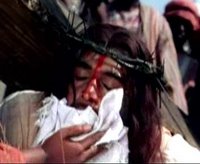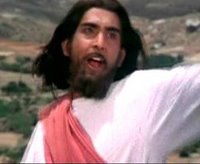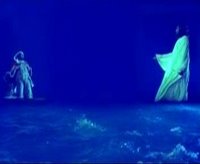Dayasagar Scene Guide
 Last week I posted my review of Dayasagar - the Indian Jesus film. As usual I like to accompany that with an analysis of the scenes in the film with accompanying gospel citations.
Last week I posted my review of Dayasagar - the Indian Jesus film. As usual I like to accompany that with an analysis of the scenes in the film with accompanying gospel citations.Annunciation - (Luke 1:26-38)Notes
Joseph's 1st Dream - (Matt 1:18-25)
Census and Birth of Jesus - (Luke 2:1-7)
Shepherds and Angels - (Luke 2:8-15)
Wise men / Magi visit - (Matt 2:1-12)
Joseph's 2nd Dream - (Matt 2:13-15)
Slaughter of the Infants - (Matt 2:16-18)
Jesus as a child - (Luke 2:40, 51-52)
[extra-biblical episodes]
John the Baptist Teaches - (Luke 3:1-18)
Baptism of Jesus - (Mark 1:9-11)
2 Disciples Follow Jesus - (John 1:35-39)
Temptations - (Matt 4:1-11)
Calling of Matthew - (Mark 2:13-17)
Healing a man with Dropsy - (Luke 14:1-6)
Sermon on the Mount - (Matt 5-7)
Healing a Leper - (Mark 1:40-45)
[extra-biblical episodes]
Walking on Water - Matt (14:22-33)
- Intermission -
Woman Caught in Adultery - (John 8:2-11)
Jesus Anointed - (Luke 7:36-50)
Blind Man Healed - (John 9:1-7)
[extra-biblical episode]
Feeding 5000 men - (Mark 6:30-44)
- Let the Children come (Mark 10:13-16)
Attempt to Crown Jesus King - (John 6:14-15)
Raising of Lazarus - (John 11:1-44)
Triumphal Entry - (Matt 21:1-9)
Clearing the Temple - (Mark 11:15-19)
Washing the Disciples Feet - (John 13:1-17)
Last Supper - (Mark 14:17-25)
Jesus's Farewell Speech - (John 14-17)
Jesus Predicts Peter's Denial - (Mark 14:27-31)
Gethsemane - (Mark 14:32-42)
Arrest - (Mark 14:43-50)
Peter's denial - (Mark 14:66-72)
Sanhedrin Trial - (Mark 14:53-64)
Pilate 1st Trial - (Mark 15:1-5)
Beating, Scourging and Mocking - (Mark 15:16-20)
Pilate 2nd Trial - (John 19:4-16)
Road to the Cross - (Luke 23:26-31)
[flashbacks]
Crucifixion - (Mark 15:22-32)
2 Thieves - (Luke 39-43)
Jesus Dies - (Mark 15:33-37)
Earthquake at Death - (Matt 27:51)
Judas Hangs Himself - (Matt 27:5)
Burial - (Mark 15:42-47)
[Resurrection shown]
Appearance Amongst Disciples - (John 21:19-28)
Reinstatement of Peter - (John 21:15-18)
Ascension - (Luke 24:50-53)
Great Commission - (Matt 28:18-20)
(John 3:16)
 This scene guide was created using an un-subtitled version of the film; hence some of it is guess work. Although it always surprises me how much of a Jesus film one can work out without speaking the language. In particular, I have no idea which passages from the Sermon on the Mount were included, only that Jesus was definitely teaching from the top of a large hill at one point.
This scene guide was created using an un-subtitled version of the film; hence some of it is guess work. Although it always surprises me how much of a Jesus film one can work out without speaking the language. In particular, I have no idea which passages from the Sermon on the Mount were included, only that Jesus was definitely teaching from the top of a large hill at one point.The film also uses a few flashbacks around the 2nd trial at the hands of Pilate. I think this might be the first Jesus film to do this
The crucifixion is incredibly bloody - probably the most violent before Mel Gibson's The Passion of the Christ in addition to it showing all of the various bits of torutre inflicted by the Romans in Mark 15:15-20 it adds scenes of Jesus walking through a patch of thorns which stick in his bare feet, and shows the blood spurting out of his hands as the nails are driven in. At this point we are shown that even the (already crucified) "bad thief" is unable to watch.
 The film contains a couple of healing scenes that are not that common amongst many Jesus films. Firstly the healing of a man with leprosy from (Mark 1:40-45 / Matt 8:1-4). Interestingly the film shows Jesus coming down the large rocky outcrop he is teaching on to heal this man, reflecting a detail in Matt 8:1 that would seem to be simply a continuity link from the Sermon on the Mount back into the structure of Mark's overall narrative. John Gilman, President of the film's main missionary distributors Dayspring International notes how there are more people with leperosy in India than there are Christians, and that as a result this scene tends to be the favourite scene when it is shown.
The film contains a couple of healing scenes that are not that common amongst many Jesus films. Firstly the healing of a man with leprosy from (Mark 1:40-45 / Matt 8:1-4). Interestingly the film shows Jesus coming down the large rocky outcrop he is teaching on to heal this man, reflecting a detail in Matt 8:1 that would seem to be simply a continuity link from the Sermon on the Mount back into the structure of Mark's overall narrative. John Gilman, President of the film's main missionary distributors Dayspring International notes how there are more people with leperosy in India than there are Christians, and that as a result this scene tends to be the favourite scene when it is shown.Secondly, the film also includes the healing of a blind man in John where Jesus uses mud made with his spit as part of the process. That always seems such a distasteful, and undignified method of healing someone that it seems unlikely that this story was fabricated by the early church as some claim.
 There are at least three scenes in this film based on events in the gospels where the variations between the different accounts of seemingly the same incident are particularly marked. In each case it is interesting that the film uses the fullest and most visual account available. Firstly, the story of Christ walking on the water and calming the storm. Only Matthew includes Peter's act of little faith as does the film.
There are at least three scenes in this film based on events in the gospels where the variations between the different accounts of seemingly the same incident are particularly marked. In each case it is interesting that the film uses the fullest and most visual account available. Firstly, the story of Christ walking on the water and calming the storm. Only Matthew includes Peter's act of little faith as does the film. Secondly, the woman who anoints Jesus. Mark (14:3-9) has the woman simply pouring the ointment over Jesus's head. Matthew's account (6:13) follows suit. But Luke does not have her anoint Jesus' head at all (other it mentions Simon's failure to do so suggesting that Mark's version - or someone else's - is at least at the back of his mind. Note also the way the name of "The Pharisee" suddenly becomes "Simon" when Jesus starts talking in 7:40), just his feet. Neither does John who ignores Jesus's host altogether. In the film, it's is Luke's most vivid account which the scene most closely resembles.
Finally, the Triumphal Entry scene actually shows Jesus with two donkeys, one of which is presumably the colt, only mentioned in Matthew as he attempts to link the event with Zechariah 9:9. Again it is the most visually full version of the story, that is filmed. Although it's not something I generally take not of, I can't think of another film that is quite so literal on this point, although I would be interested to re-watch the same incident from Pasolini's and the Visual Bible's version of Matthew in that respect.
Labels: Dayasagar, Indian Jesus Films, Scene Guides














3 Comments:
At 3:07 pm, July 03, 2006, D H Friesen said…
D H Friesen said…
Thanks for this, Matt. Your gospel citation list is very helpful, and I concur from my own initial observations of the film that it is surprising how much one can figure out without knowing the language.
It also appears to me that you have a copy of one of the older versions in circulation. The updated DVD version now produced and used by Dayspring does not include the scene of Jesus walking on water.
A couple of further comments if I may. Perhaps you can correct me here, but I think it is one of the first films of Jesus' life in which we see Joseph playing an active paternal role during the nativity. He actually walks around holding the baby Jesus. Not for long, mind you.
Second, your observations about the precedence of Chandar's use of flashbacks in the genre is affirming for me. I had made the comparison to Gibson's film as well, but I think you've seen more Jesus films than I have to date, so your comments bolstered my confidence.
As for the content of the Sermon on the Mount: the script basically follows Matthew 5:3-10. Your observation regarding the connection to Matt. 8:1 is one I hadn't picked up. Duh! Thanks.
I really appreciate your work here. Hopefully my essay on the film (though it already feels somewhat dated) will be helpful too. I'm holding back on the details at the moment, because I'm new to publishing protocol, but it has been "forthcoming" for several months now.
All the best,
Dwight Friesen
At 9:49 am, July 04, 2006, Matt Page said…
Matt Page said…
Thanks for your comment Dwight. I haven't really noted Joseph's role in fathering in the various films, although I suspect you may be correct. To be honest I tend to find the nativity sequences fairly dull - heavily laden with a heavy dose of kitsch. However, this one was definitely much more interesting, and defly executed.
Matt
At 10:08 pm, November 14, 2015, Super Management said…
Super Management said…
Hello Matt,
I am a close relative of Vijay Chander and if you want to know more about Karunamayudu, please do not hestate to contact me.
Thank You
Madan Luthra
Post a Comment
<< Home